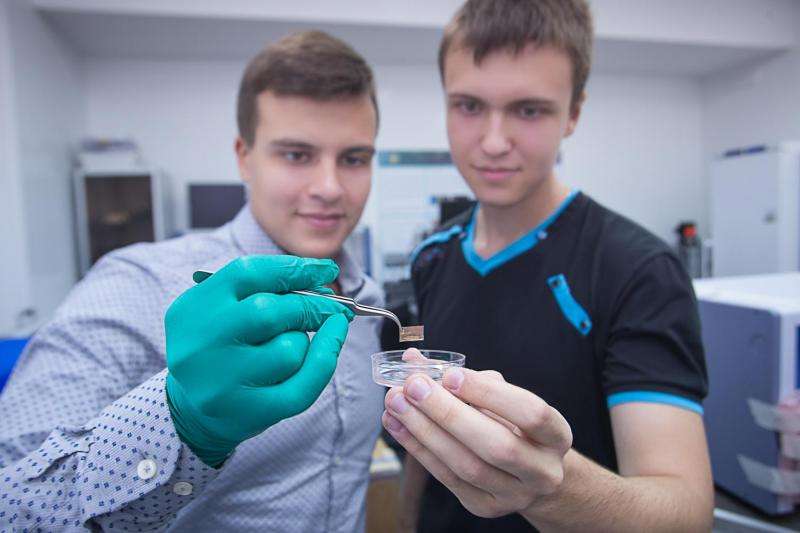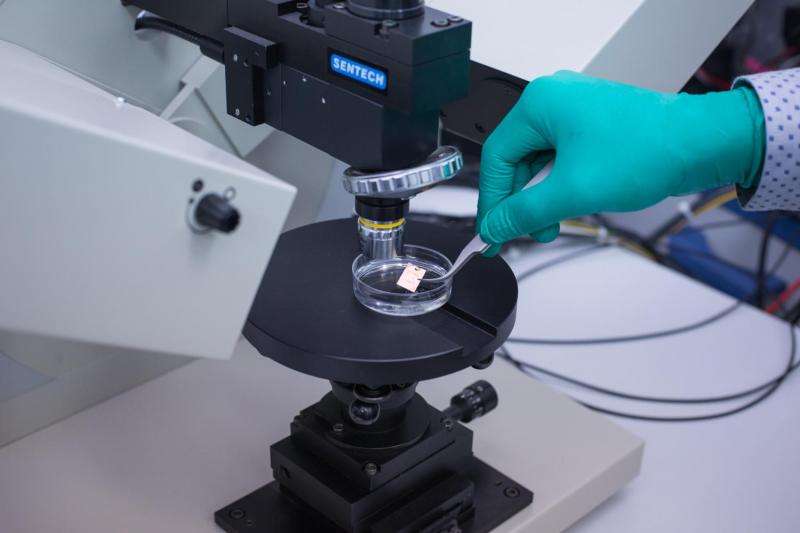New graphene oxide biosensors may accelerate research of HIV and cancer drugs

Longing to find a cure for cancer, HIV and other incurable diseases, researchers have already tried out hundreds of drugs, each requiring preclinical and clinical testing with live subjects. How many more chemical agents to try? At such a rate, will we find the cure during our lifetime?
One of the easiest ways to speed up the drug development process is to simply perform it outside of the living body (e.g., by watching the substances react with the smallest samples of live tissue and thus quickly predicting the overall effect it will have inside the body). This approach will eventually provide a more effective preclinical selection of drug candidates for long-term and expensive clinical trials. This could get science closer to long-sought cures.
Researchers from the Laboratory of Nanooptics and Plasmonics, Moscow Institute of Physics and Technology - MIPT (Russia) have devised a novel type of graphene oxide (GO) biosensor that could potentially speed up the process of drug development. The outstanding properties of this carbon allotrope significantly improve the biosensing sensitivity, which in the future may enable the development of new drugs and vaccines against many dangerous diseases including HIV, hepatitis and cancer. The research, led by Yury Stebunov, a scientist at the MIPT, was published in the ACS Applied Materials & Interfaces. The paper is titled "Highly sensitive and selective sensor chips with graphene-oxide linking layer." Valentyn Volkov is the co-lead author, a visiting professor from the University of Southern Denmark. Other co-authors are Olga Aftenieva and Aleksey Arsenin.
New GO-based biosensor chips exploit the phenomenon of surface plasmon resonance (SPR). Surface plasmons are electromagnetic waves propagating along a metal-dielectric interface (e.g., gold/air) with amplitudes that exponentially decay in the neighboring medium. Adsorption of molecules from a solution onto a sensing surface alters the refractive index of the medium near this surface and, therefore, changes the conditions of SPR. These sensors can detect biomolecule adsorption even at a few trillionths of a gram per millimeter square. Owing to these properties, SPR biosensing is an outstanding platform to boost technological progress in the areas of medicine and biotechnology. Nevertheless, the most distinctive feature of such sensors is the ability to "visualize" molecular interactions in real time.
"SPR biosensing is a valuable tool to investigate a wide range of biochemical reactions, estimate their chemical kinetics and other characteristics. All this can be efficiently used for new drug discovery and validation. Widespread introduction of this method into preclinical trials will completely change the pharmaceutical industry. With SPR sensors, we just need to estimate the interaction between the drug and targets on the sensing surface," Stebunov said.

Most commercial SPR sensor chips comprise a thin glass plate covered by gold layer with thiol or polymer layers. The biosensitivity depends on the properties of the chip surface. Higher binding capacity for biomolecules increases the signal levels and accuracy of analysis. Over the last several years, novel carbon materials like graphene have attracted much attention due to their large surface area, low-cost fabrication, and interaction with a wide range of biomolecules.
Stebunov and the team from the Laboratory of Nanooptics and Plasmonics at MIPT created and patented a novel type of SPR sensor chips with the GO linking layer. The material has more attractive optical and chemical properties than pristine graphene. The GO "flakes" were deposited on the 35 nm gold layer, followed by a layer of streptavidin protein for selective immobilization of biomolecules.
Scientists conducted a series of experiments comparing the GO chip, a commercially available chip with a carboxymethylated dextran (CMD) layer, and a chip covered by monolayer graphene. Experiments showed that the proposed GO chip has three times higher sensitivity than the CMD chip and 3.7 times than the chip with pristine graphene. These results mean that the new chip needs fewer molecules for detecting a compound and can be used for analysis of chemical reactions with small drug molecules. An important advantage of the new GO-based sensor chips is their simplicity and low-cost fabrication compared to sensor chips that are already commercially available.
"Our invention will help in drug development against viral and cancer diseases. We are expecting that the pharmaceutical industry will express a strong demand for our technology," Stebunov said.
"The sensor can also find applications in food quality control and toxin screening, and the sensor can significantly shorten the time for a clinical diagnostic," researcher added. However, clinical trials with the chip are still needed for medical applications.
More information: Y.V. Stebunov, O.A. Afteneva, A.V. Arsenin, V.S. Volkov, "Highly sensitive and selective sensor chips with graphene-oxide linking layer." ACS Applied Materials & Interfaces DOI: 10.1021/acsami.5b04427
Journal information: ACS Applied Materials and Interfaces
Provided by Moscow Institute of Physics and Technology




















